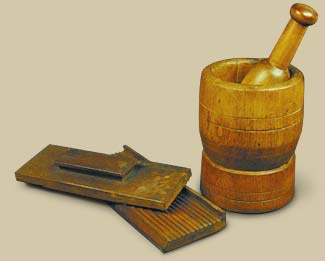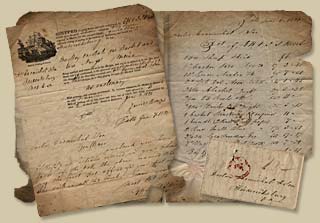Letters to Doctor James Carmichael & Son
Historical Collections at the Claude Moore Health Sciences Library, University of Virginia
IMPORTANT: Please upgrade your browser to view this site as intended.
Site Navigation
Path to Current Page

- Pill Press and Mortar & Pestle (c. 1800s). The mortar and pestle have been tools of pharmacy for thousands of years.
Doctor Carmichael and his sons acted as their own pharmacists.
Many of their patients lived on estates or farms outside the city of Fredericksburg. Because traveling was time consuming for both the patient and doctor, frequently a letter was delivered to the Carmichaels’ office with a description of the illness and a plea for medicine. Upon reading the letter, the Carmichaels dispensed the appropriate medicine and sent the bearer (often a slave) back with the drug and instructions on its proper use.
If a family member determined the patient was extremely ill, the Carmichaels made a house call. In many letters, the authors urgently requested that one of the Carmichaels quickly ride to their plantation to tend to an ill family member or slave. The doctor who rode out to attend the patient carried his medicinal arsenal with him, either in a medical bag or saddlebag. After examining a patient and determining a course of treatment, he probably dispensed and compounded his own medications at the patient’s bedside. In the early nineteenth century, two to five ingredients were generally combined into one prescription. Carmichael possibly weighed out the necessary drugs using a handheld scale brought with him in his doctor’s bag. The mixture would then be administered as a pill, a powder (given dry or suspended in water), a water solution, a tea, or as a tincture (an alcoholic solution). Using a little soap, water, or gum arabic as a binding agent, the Carmichaels could individually hand roll a pill at the bedside.

- The Carmichaels kept abreast of medical developments by purchasing books through Thomas Dobson & Son, a publishing house located in Philadelphia.
Unlike modern physicians, doctors practicing in the early half of the nineteenth century lacked the scientific knowledge to treat many diseases effectively. Multitudes of minerals and botanicals were available, but the efficacy of the drugs was limited. Quinine for malaria, digitalis for dropsy, and opiates for pain relief were a few of the useful drugs that the Carmichaels employed. Other drugs in the Carmichaels’ doctor bags would include cathartics (laxatives), anti-diarrheal agents, emetics (to induce vomiting), caustics, and smelling salts.
- Quinine (Cinchona or Jesuits’ Bark)

Quinine was a necessary staple in the pharmacy of a Southern physician. Large doses were employed to combat malaria, one of the most common diseases in the antebellum South. The disease causes a pattern of chills (“agues”) and fever, also referred to in the nineteenth century as intermittent fever or bilious fever.
Gentlemen,
Mrs. Battaile has had an
attack of the ague & fever - You will
oblige me by sending by the bearer
a phial of Quinine.yr. obt. Sert.
Lau: BattaileAugust 31. 1827
- Paregoric (Camphorated tincture of opium)
- Paregoric was used to relieve pain, as a sedative, and as an anti-diarrheal agent. Physicians frequently used it as a pediatric drug.
Novr 2nd. 1826
Doctors Carmichael
I shall be greatly obliged
to you to send by sam four ounces of castor
oil and two of paragoric for a sick babyyour friend
Lucy Alexander
- Calomel (Mercurous chloride)
- Calomel had its origins in East Asia and was introduced into Western culture in the sixteenth century where its popularity as a cathartic quickly grew. Calomel was found in the physician’s bag as well as in a family’s own medicine cabinet. In the Carmichael letters, the frequent and varied uses of this drug are described. Calomel was given to slave children to expel worms, to adult slaves as a treatment for swollen eyes, to counteract dysentery in infants, and even to treat the ague and fever. However, there were severe side effects from taking calomel including soreness, inflammation, and recession of the gums.
Dear Sir
My little child's bowels are very
much disordered, they have been so for several
days, his discharges are frequent & copious and
very green, he has taken Rhubarb & paregorick
and castor oil & chalk, he appears to be in
great pain when he has an evacuation
I will thank you to send me something
to relieve him, I had an idea of giving him
calomel but his mother was afraid, if you
recommend it he shall take ityour's &c
James S. MauryRumford June 26th. 1823
the child is 3 mo: old
- Laudanum
- Laudanum, an extract of opium, was used as a sedative and for pain relief. The Carmichaels and their patients recognized opium as an addictive drug. It is quite possible that Herndon Frazer’s wife was addicted to laudanum. Frazer writes, “my wife has taken the laudaneum[sic] until I believe her system is completely saturated with it.”
Sycamores
May the 19th 1828Dear Dr
My Wife is very Ill much
Worse than when you saw her. The
Bowell complaint very much increased
I will thank you to come down to see
her. Please bring a Phial of Laudenum
With youYours very Respectfully
Louis W. Taliaferro
- Camphor (Camphora)
- Camphor is a white, brittle substance with a fragrant odor but a bitter, pungent taste. When opium failed, camphor was used to promote sleep. The Carmichaels also prescribed it to relieve fever.
Wood Land Feb.r 28.th 1826
Dear SirIf you possibly can you will confer a favour to
come and see Mr. Withers hip, it is very much swelled and
very painful, yesterday it look'd a littel purple but I have not
seen it this morning, also send another vial of the camphora
ted mixture as his fevers are very high. I apply to the hip
a poultice of Red Oak bark.I remain Dr. Sir
Yours Very RespectfullyElizabeth C. Withers
PS I should be glad if you
would ride out yourself and
see Mr. W.s. hip, as I prefer
your coming to your son's
ECW
- Epsom Salts
- Epsom salt, the popular name for magnesium sulfate, was a cathartic used to treat fevers, inflammatory disorders, colic, and constipation. It was considered effective and well tolerated by the stomach.
I will thank you to send me a bottle of best
Castor Oil and a pound of Epsom Salts, on the [Robert’s]
Account as his Negroes are frequently in want – pray don’t
Fail Coming.Larkin Stanard
Roxbury
23 Octr. 1829
Vaccinations
Edward Jenner’s paper relating his success using cowpox to vaccinate against smallpox was published in 1798. In spite of the strong support of people like Thomas Jefferson, who personally vaccinated his slaves at Monticello, the American public was slow to accept this new method of protection against disease. In the time period of the Carmichaels, vaccination was practiced only in the face of an outbreak. In an 1828 letter written to the Carmichaels by Mary Skinker, she wrote they were in a “great state of alarm” hearing that their neighbors were infected with smallpox. She continued:
We wish you to come up, and vaccinate our Children & negroes, & pursue what course, you think best, to prevent this disorder from spreading through our family. I have had the small-pox, Mr. Skinker has been vaccinated, but the children did not take the vaccination, administered by you, when you were last here.
- Receipt from George & J.S. Keerl, June 7, 1820.

- The Carmichaels purchased the majority of their pharmaceutical supplies and instruments from George and J.S. Keerl located in Baltimore, Maryland. The items were shipped on schooners from Baltimore to Fredericksburg. [see receipt from George H. Keerl and J. S. Keerl, June 7, 1820]
© 2019, Rector and Visitors of the University of Virginia
Historical Collections and Services at the Claude Moore Health Sciences Library